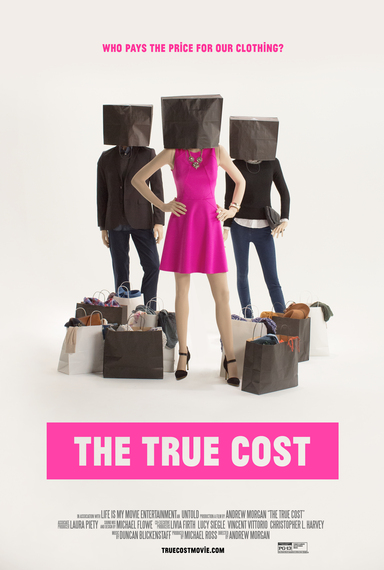Millennials love cheap makeovers -- and why not? If you have a closet full of nothing to wear, just head over to the nearest Zara or Joe Fresh, wave your credit card and score some spankin' new, on-trend outfits without breaking the bank.
'This is a story about clothes,' the True Cost documentary starts; but it is so much more than that.
In ninety minutes, the documentary juxtaposes the product and process. The camera jumps from glamouros European catwalks to the Indian slums in which those garments are created. But wait, how did that happen?
When our mothers were our age, they couldn't easily afford to buy a dozen shirts on one shopping trip. Could you imagine passing down your H&M dress to your great granddaughter? You'd be lucky if it lasted beyond one season.
Like fast food took over our kitchens, fast fashion took over our closets.
The big companies today seem to measure success by the final product on the runway or on the shelves. They likely don't think about the mothers who are forced to live away from their toddlers in order to create those fast fashion items on wages that are too low to live on.
Cinderella's singing mice aren't working behind the scenes to sew garments in your bedroom.
Real people are doing it, who have real lives. Far from the eyes of the world, companies are getting away with murder -- literally. Factory fires, building collapses and diseases have all killed factory workers recently. And these aren't isolated incidents. Workers are getting skin cancer as well as digestive and liver problems -- all health issues directly related to the chemicals found in those factories. It doesn't seem to be slowing down either. The U.S. was producing 95% of the clothes domestically in the 1960s. Today, it's more like three percent.
The rest of the production is outsourced to developing countries and those atrocities are increasing steadily.
The documentary encourages the viewer to get off the conveyer belt of constant motion and focus on the living things that breathe life into garments.
Many companies are contaminating the land and adding toxicity to the soil. Crops and people are affected and the earth is being abused. They estimate that one cotton farmer commits suicide every 30 minutes. This new destruction isn't just impacting third world countries though.
Clever ads tie consumption to happiness, but people in the Western World seem much more depressed.
In the past, getting a new dress was an event. You would eye an item at the store, dream about it, work hard for it and when you finally got the prized package in your hand, it was a real treat. You would take care of it and wear it on special occasions. Today, you can purchase six affordable pretty dresses with one click online.
After that selfie, that dress becomes too old and you head to the shop to buy another piece to lift your mood.
We are just consuming and adding without thinking of the consequences. Only 10 percent of donated clothes get recycled or up-cycled, and thrift stores can't sell a lot of the garments that come in, so they end up in a landfill.
Fashion bloggers clutter YouTube with vlogs and confess that they can't physically wear everything. "I don't even know if I like it anymore," one blogger confesses after showing her new purchase to the camera.
Since it takes 200 years to break down textile, the clothes just sit there releasing harmful fumes in the atmosphere for centuries.
Packed with mini narratives and interviews with designers and factory workers, the documentary was paid for by participants on the crowdfunding site, Kickstarter. About 900 strangers funded the project which took 2.5 years to make.
Watching the documentary, you are reminded that cheap fashion might be friendly on the wallet but harmful for humanity. The main takeaway is this: Don't be a "Fashion Victim" and, if you buy something new, try to make sure that there aren't any victims at all. Available on Netflix. More at The True Cost Movie.
